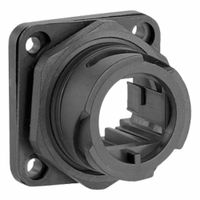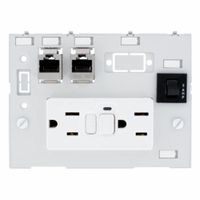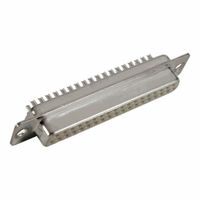Call +(254) 703 030 000 / 751 483 999 / 721 704 777
- Home
- Electrical
- Electrical Connectors Wiring Devices
- Data Network Interface Connectors
- Industrial Service Interface Connectors
.....Read More
Frequently Asked Questions
What are the different types of industrial connectors and their applications?
1. **Circular Connectors**: Used in automation, robotics, and aerospace for their robust design and ease of connection. They provide secure connections for power, signal, and data transmission.
2. **Rectangular Connectors**: Common in industrial machinery and control systems, offering high-density connections and modularity for complex wiring needs.
3. **DIN Connectors**: Utilized in audio equipment, computer interfaces, and industrial automation, known for their standardized design and reliability.
4. **RF Connectors**: Essential in telecommunications and broadcasting, these connectors handle radio frequency signals and are used in antennas and wireless systems.
5. **Fiber Optic Connectors**: Used in data centers and telecommunications for high-speed data transmission over long distances with minimal signal loss.
6. **Heavy-Duty Connectors**: Designed for harsh environments, they are used in construction, mining, and transportation industries to withstand extreme conditions.
7. **Terminal Blocks**: Employed in electrical panels and control systems for secure wire connections, allowing easy circuit modifications and maintenance.
8. **PCB Connectors**: Found in electronic devices and circuit boards, they facilitate connections between different components and modules.
9. **Modular Connectors (RJ45, RJ11)**: Used in networking and telecommunications for connecting Ethernet cables and telephone lines.
10. **USB Connectors**: Widely used in computers and consumer electronics for data transfer and power supply.
11. **D-Sub Connectors**: Common in computer and industrial applications for connecting peripherals and serial communication.
12. **M12/M8 Connectors**: Used in sensor and actuator connections in industrial automation, providing compact and reliable connections.
13. **Anderson Power Connectors**: Utilized in power distribution and battery connections for their high current capacity and durability.
14. **Coaxial Connectors**: Used in cable television, internet, and radio frequency applications for transmitting high-frequency signals.
15. **MIL-Spec Connectors**: Designed for military and aerospace applications, offering high reliability and resistance to environmental factors.
How do I choose the right connector for my industrial application?
1. **Application Requirements**: Identify the specific needs of your application, including the type of signals (power, data, or mixed), voltage, current ratings, and environmental conditions.
2. **Environmental Conditions**: Consider the operating environment. For harsh conditions, choose connectors with appropriate IP ratings for dust and moisture resistance, and materials that withstand temperature extremes, chemicals, or UV exposure.
3. **Mechanical Requirements**: Evaluate the mechanical robustness needed. Consider factors like vibration, shock, and the number of mating cycles. Choose connectors with secure locking mechanisms if necessary.
4. **Electrical Specifications**: Ensure the connector meets the electrical requirements, including current-carrying capacity, voltage rating, and impedance. Check for compatibility with the system's electrical characteristics.
5. **Size and Weight**: Consider the physical constraints of your application. Choose connectors that fit within the available space and meet weight limitations, especially in portable or space-constrained applications.
6. **Connector Type**: Decide between circular, rectangular, or other shapes based on space, ease of use, and connection density. Consider modular connectors for flexibility.
7. **Material and Plating**: Select materials that provide the necessary durability and corrosion resistance. Common materials include plastic, metal, and composites. Plating options like gold or tin can affect conductivity and corrosion resistance.
8. **Standards and Certifications**: Ensure the connector complies with relevant industry standards and certifications, such as UL, CE, or RoHS, to meet safety and regulatory requirements.
9. **Cost and Availability**: Balance performance with budget constraints. Consider the total cost of ownership, including installation and maintenance. Ensure the chosen connector is readily available from reliable suppliers.
10. **Future-Proofing**: Consider potential future needs, such as increased data rates or additional connections, to avoid premature obsolescence.
What are the key differences between Ethernet and USB connectors?
Ethernet and USB connectors serve different purposes and have distinct characteristics:
1. **Purpose**:
- Ethernet connectors are primarily used for networking, allowing devices to communicate over a local area network (LAN) or connect to the internet.
- USB connectors are designed for connecting peripherals to a computer, such as keyboards, mice, printers, and storage devices.
2. **Connector Types**:
- Ethernet typically uses RJ-45 connectors, which are larger and have eight pins.
- USB connectors come in various types, including USB-A, USB-B, USB-C, Micro-USB, and Mini-USB, with different pin configurations and sizes.
3. **Data Transfer Rates**:
- Ethernet speeds vary from 10 Mbps (Ethernet) to 100 Gbps (Ethernet over fiber optics), with common standards like Fast Ethernet (100 Mbps) and Gigabit Ethernet (1 Gbps).
- USB speeds range from USB 1.0 (1.5 Mbps) to USB 4 (up to 40 Gbps).
4. **Power Delivery**:
- Ethernet does not typically provide power, though Power over Ethernet (PoE) can deliver power to devices like IP cameras and phones.
- USB can deliver power to connected devices, with USB Power Delivery (PD) allowing up to 100 watts.
5. **Cable Length**:
- Ethernet cables can be up to 100 meters long without signal degradation.
- USB cables are generally limited to 5 meters for USB 2.0 and 3 meters for USB 3.0 without using repeaters or active cables.
6. **Usage**:
- Ethernet is used for stable, high-speed network connections.
- USB is used for connecting and powering peripherals, data transfer, and charging devices.
7. **Hot Swapping**:
- USB supports hot swapping, allowing devices to be connected/disconnected without shutting down the system.
- Ethernet connections can also be plugged/unplugged without system shutdown, but this is less common in practice.
How do I ensure the durability and reliability of connectors in harsh environments?
To ensure the durability and reliability of connectors in harsh environments, consider the following strategies:
1. **Material Selection**: Use corrosion-resistant materials such as stainless steel, nickel-plated brass, or high-grade plastics. These materials withstand extreme temperatures, moisture, and chemical exposure.
2. **Sealing and Enclosures**: Implement robust sealing techniques like O-rings, gaskets, and potting compounds to prevent ingress of dust, water, and other contaminants. Use IP-rated enclosures for additional protection.
3. **Plating and Coatings**: Apply protective coatings such as gold or tin plating to prevent oxidation and corrosion. These coatings enhance conductivity and reduce wear.
4. **Vibration and Shock Resistance**: Design connectors with features like locking mechanisms and strain reliefs to withstand mechanical stresses. Use flexible cables and secure mounting to minimize movement.
5. **Temperature Management**: Select connectors with appropriate thermal ratings. Use heat sinks or thermal pads to dissipate heat and prevent thermal degradation.
6. **EMI/RFI Shielding**: Incorporate shielding to protect against electromagnetic and radio frequency interference, ensuring signal integrity.
7. **Regular Maintenance and Inspection**: Implement a maintenance schedule to inspect connectors for wear, corrosion, and damage. Replace or repair as necessary to maintain performance.
8. **Testing and Certification**: Use connectors that meet industry standards and certifications for harsh environments, such as MIL-SPEC, IP ratings, or NEMA standards.
9. **Redundancy and Backup Systems**: Design systems with redundant connectors to ensure continued operation in case of failure.
10. **Proper Installation and Training**: Ensure connectors are installed correctly by trained personnel to prevent damage and ensure optimal performance.
By integrating these strategies, connectors can maintain functionality and reliability even in the most challenging conditions.
What maintenance practices are recommended for industrial connectors?
1. **Regular Inspection**: Conduct routine visual inspections to check for signs of wear, corrosion, or damage. Look for loose connections, broken pins, or cracked housings.
2. **Cleaning**: Use appropriate cleaning agents to remove dust, dirt, and debris. Avoid harsh chemicals that can damage the connectors. Use compressed air for hard-to-reach areas.
3. **Lubrication**: Apply suitable lubricants to prevent corrosion and ensure smooth mating and unmating. Use only lubricants recommended by the manufacturer.
4. **Tightening**: Ensure all connections are securely tightened to prevent loosening due to vibration or thermal expansion. Use torque tools to apply the correct amount of force.
5. **Replacement of Damaged Parts**: Replace any damaged or worn-out components immediately to prevent failure. Keep spare parts readily available for quick replacements.
6. **Environmental Protection**: Use protective covers or enclosures to shield connectors from environmental factors like moisture, dust, and chemicals.
7. **Cable Management**: Ensure proper cable routing and strain relief to prevent stress on the connectors. Use cable ties and clamps to secure cables.
8. **Testing**: Perform regular electrical testing to ensure connectors are functioning correctly. Use multimeters or specialized testing equipment to check for continuity and resistance.
9. **Training**: Ensure personnel are trained in proper handling and maintenance procedures to prevent accidental damage.
10. **Documentation**: Maintain detailed records of maintenance activities, inspections, and any issues encountered. This helps in tracking the performance and scheduling future maintenance.
11. **Follow Manufacturer Guidelines**: Adhere to the manufacturer's maintenance recommendations and guidelines for specific connector types.
12. **Upgrade and Retrofit**: Consider upgrading to newer, more reliable connectors if frequent maintenance is required or if the connectors are outdated.
How do I install and replace industrial panel interface connector inserts?
1. **Power Down and Safety**: Ensure all power sources to the panel are disconnected. Wear appropriate personal protective equipment (PPE).
2. **Access the Panel**: Open the panel door or cover to access the connectors. Use appropriate tools to remove any screws or fasteners.
3. **Identify the Connector**: Locate the specific connector insert that needs replacement. Note its type and configuration for accurate replacement.
4. **Remove the Old Insert**:
- Disconnect any cables or wires attached to the insert.
- Use a screwdriver or appropriate tool to release any locking mechanisms.
- Carefully pull out the old insert from the connector housing.
5. **Prepare the New Insert**:
- Verify the new insert matches the specifications of the old one.
- Inspect for any damage or defects before installation.
6. **Install the New Insert**:
- Align the new insert with the connector housing.
- Push it into place until it clicks or locks securely.
- Ensure it is seated properly and all locking mechanisms are engaged.
7. **Reconnect Wiring**:
- Attach the cables or wires to the new insert, ensuring correct polarity and secure connections.
- Use cable ties or clamps to manage and organize the wiring.
8. **Test the Connection**:
- Reconnect power to the panel.
- Test the functionality of the new insert by checking for proper operation of connected devices.
9. **Close the Panel**:
- Secure the panel door or cover with screws or fasteners.
- Ensure all safety measures are reinstated.
10. **Document the Replacement**: Record the replacement details, including date, part number, and any observations, for maintenance records.
What are the common issues and troubleshooting tips for industrial connectors?
Common issues with industrial connectors include:
1. **Corrosion**: Exposure to moisture and chemicals can lead to corrosion. Use corrosion-resistant materials and ensure proper sealing.
2. **Mechanical Damage**: Physical impacts can damage connectors. Implement protective housings and ensure proper handling.
3. **Improper Mating**: Misalignment during connection can cause damage. Use guides and ensure connectors are properly aligned before mating.
4. **Wear and Tear**: Frequent connections and disconnections can wear out connectors. Regularly inspect and replace worn connectors.
5. **Contamination**: Dust and debris can interfere with connections. Use dust caps and clean connectors regularly.
6. **Overheating**: Excessive current can cause overheating. Ensure connectors are rated for the current load and check for proper ventilation.
7. **Loose Connections**: Vibration can loosen connections. Use locking mechanisms and regularly check for tightness.
8. **Signal Loss**: Poor connections can lead to signal degradation. Ensure connectors are clean and properly seated.
Troubleshooting tips:
- **Visual Inspection**: Regularly inspect connectors for signs of damage, corrosion, or contamination.
- **Cleaning**: Use appropriate cleaning solutions and tools to remove dirt and corrosion.
- **Tightening**: Check and tighten connections to prevent loosening due to vibration.
- **Replacement**: Replace damaged or worn connectors promptly to prevent further issues.
- **Testing**: Use multimeters or other testing equipment to check for continuity and proper function.
- **Environmental Protection**: Use appropriate enclosures and seals to protect against environmental factors.
- **Training**: Ensure personnel are trained in proper handling and maintenance of connectors.




